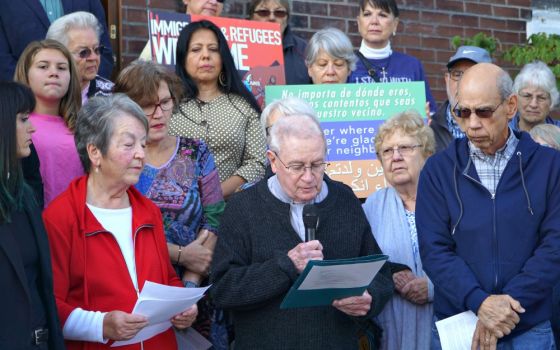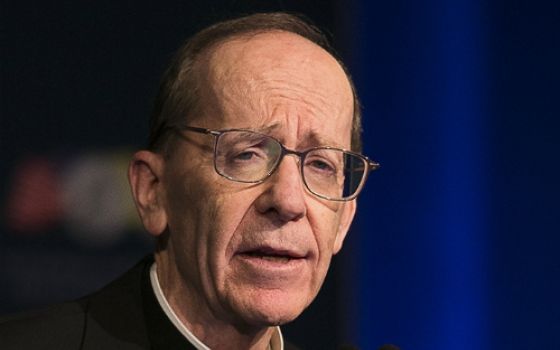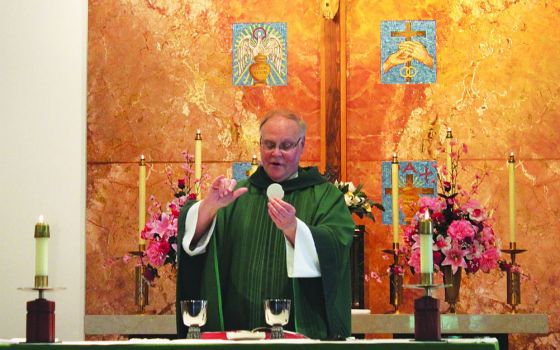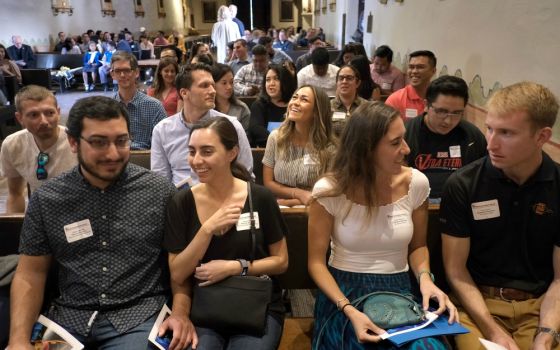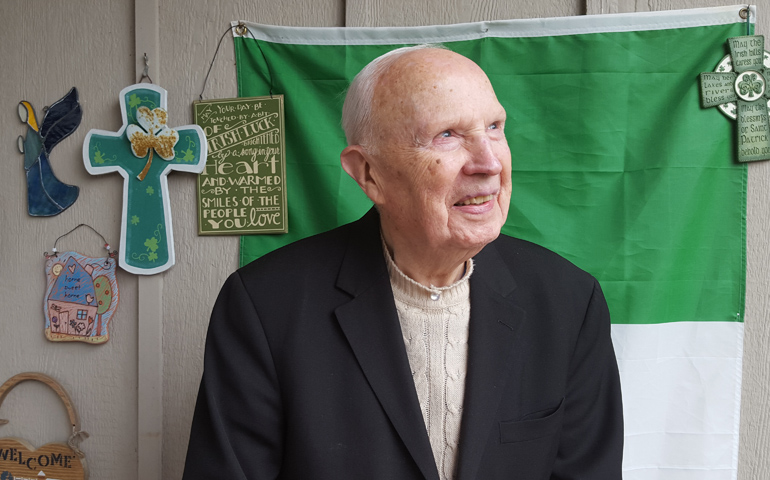
Fr. William Treacy (Dan Morris-Young)
As a young Irish priest in 1944, William Treacy raised his hand when his bishop asked for volunteers to help out for a while in a U.S. archdiocese short of priests because of the world war.
Little did he know that his temporary assignment in the Seattle archdiocese would last the rest of his life. Nor did he imagine he would become a Pacific Northwest media personality, the founder of a 200-acre facility dedicated to interreligious dialogue, a sought-after speaker, a widely read author, and beloved pastor.
Treacy, who turns 97 on May 31, is still going strong -- residing at the Treacy Levine Center he helped establish in 1966, presiding at Masses weekly, witnessing marriages, celebrating funerals, leading retreats and writing.
And, he says, continuing to do all he can to encourage "unity and harmony in the human family" through dialogue, common cause and mutual respect.
Fr. Michael Ryan, 75, who was a fourth-grade altar boy for Treacy, calls the nonagenarian "a one-man ecumenical-interfaith movement."
"Bill is a giant in my book," said Ryan, long the pastor of Seattle's St. James Cathedral. "He has always been ahead of his time. Even now, in his mid-90s, he's out there scanning the horizon, looking for ways to read the signs of the times in the light of the Gospel."
Treacy's broad and informed views of ecumenical and interreligious dialogue were hewn, refined and polished, he says, in large part through his close friendship and work with the late Raphael Levine, the leader* of Seattle's Temple De Hirsch.
Treacy and Levine were introduced in 1960 when the rabbi and the local ABC television affiliate approached the archdiocese with the idea of creating a television program that would deal with religious and social issues through the lens of interreligious dialogue.
Archbishop Thomas Connolly was open to the notion and tapped Treacy, director of the Catholic Information Center, to follow through.
With the strong encouragement of KOMO-TV station manager William Warren, "Challenge" was born. Treacy and Levine were the program's mainstays. A handful of Protestant co-hosts rotated through the program over the years.
The prime time (6 p.m.) Sunday weekly half-hour broadcast ran for 14 years, garnering myriad honors, including a special 1962 award from the National Conference of Christians and Jews, mainly for the program's treatment of the question "Who crucified Jesus?"
1962 also marked the World's Fair in Seattle and the opening of the Second Vatican Council in Rome.
The council provided ongoing grist for "Challenge" -- including marked changes in the Catholic church's relationships to other religions, and the eventual recasting of the eucharistic liturgy.
Treacy recalls receiving a letter from the archbishop of Vancouver, British Columbia, thanking him and his "Challenge" colleagues for explaining the Vatican II process and conclusions to his faithful.
For the World's Fair, Connolly appointed the Irishman "director of non-Catholic welcome," which included inviting leaders of all faiths to take part in what was dubbed "Liturgical Week" in late August at the fairgrounds.
One of Treacy's fondest memories of that time is how the Seattle-area Knights of Columbus, with the collusion of Connolly and Levine, secretly flew Treacy's mother, Mary, from Ireland to be honored as the Knights' Mother of the Year.
The World's Fair committee named Mary Treacy "World's Fair Mother" and staged a special evening for her and her son at the Space Needle.
Treacy says his friendship with Levine profoundly impacted him. "This rabbi has changed my life more than anyone else I have met. I trust and honor him as a father," the priest wrote in a book co-authored with Levine in 1974, Wild Branch on the Olive Tree. The pair collaborated on eight books.
Treacy said that Levine was fond of pointing out that both of them came from ghettos -- the priest from the Irish ghetto, and the rabbi from a ghetto in Russian-occupied Vilna, Lithuania. The rabbi insisted that they combat an insular, ghetto mentality.
With Levine pushing the idea, the pair generated backing to purchase a 300-acre dairy farm about an hour north of Seattle to be dedicated to interreligious endeavors.
Their early hope was to persuade different faith groups to each lease or buy five acres in a kind of interreligious real estate quilt. There would be common places to eat, pray and recreate. The concept proved unworkable.
However, after selling off 100 acres to stabilize finances, Camp Brotherhood was founded with a goal of fostering dialogue, respect and understanding between all faiths and even non-believers.
"We have never wanted to change anyone's religion," Treacy emphasizes. "We want to help our guests find peace and courage on their life journey by their experiencing our vision for the human family."
Over the years, the site has grown to include multiple buildings, including barns and sheds, residential facilities, a chapel, an auditorium and a library. The facility was renamed the Treacy Levine Center in 2014. Levine died in 1985 following an auto accident.
Innumerable events and gatherings have been staged there, such as "hosting 34 preteens from Israel and Palestine" in 2014, Treacy said. "While grownups were killing each other, parents from both sides sent their children to Treacy Levine Center, a distance of 10,000 miles, to get to know and respect one another."
In 2013, the center hosted what was called "the first reunion of religious leaders from one of the longest-running interreligious dialogues ever conducted," an international conference with 37 presentations by "spiritual pioneers and religious leaders" from around the world.
Among Catholic presenters were Treacy and famed Trappist Thomas Keating, a pioneer of centering prayer and key figure in the long-held Snowmass dialogues. The two priests know one another well. Many years ago, Treacy traveled to St. Benedict's Monastery in Snowmass, Colo., to learn more about meditation and centering prayer from Keating.
To this day, Treacy meditates a half hour in the morning and evening.
"Fr. Treacy and Rabbi Levine pioneered interreligious dialogue in the mass media," Keating told NCR. "They made it inspiring and engaging week after week on Seattle television." And the Treacy Levine Center "continues to serve the maintenance and growth of interreligious friendship and understanding," Keating said.
Treacy talks sadly about the repercussions of a 2009 visit to the center by a delegation from Pakistan. Its leader, Khial Akbar Afredi, was assassinated on his return home, presumably by the Taliban.
As the center celebrates its golden jubilee year, its work will dramatically shift gears in the near future. Its board of directors voted April 16 to sell the facility and use the funds to endow future events, seminars, programs and conferences on interfaith dialogue and other topics. Expected proceeds are about $3 million, Treacy said.
The name Treacy Levine Interfaith Foundation has been floated.
Treacy said he envisions treatment of issues such as suicide, homelessness, racism, family, immigration, and interfaith understanding.
"If I have ever felt the Holy Spirit, I feel it now," Treacy said about the decision to sell the center. "I am completely at peace with this decision, and deep in my heart I believe we are doing the right thing."
"In the Bible, it says 'go out into the highways and byways' which we will be doing in keeping with our original purpose," he added.
Bishop George Thomas of Helena, Mont., views Treacy as "a man ahead of his time and perpetually young at heart."
Calling Treacy a "trailblazer," Thomas said in an email to NCR, "In the post-conciliar era, when ecumenical and interfaith relationships were largely unrealized and unexplored, Fr. Treacy opened new trails and forged new friendships."
As Seattle's vicar general before being named a bishop, Thomas worked several years alongside Treacy. "He understands the power of dialogue over diatribe, persuasion over polemics, and invitation over invective," the bishop wrote.
Semiretired Fr. James Dalton agrees. "Fr. Bill Treacy has been a Northwest icon of ecumenical and interfaith dialogue for more than 50 years. He is legendary in his ability to unite people of varying faith perspectives. To talk with him even only once is to form a lasting friendship."
Like Ryan, Dalton was an altar boy for Treacy at St. Patrick Parish on Seattle's Capital Hill.*
"I revere his unconditional love of people and dedicated service to our Catholic church. As a priest of more than 70 years, he continues his ministry to bring harmony to the human family," said Dalton.
"His memory is also legendary," Dalton noted, adding that he and Treacy dine together almost weekly. "He has an historical recollection for almost every one he meets. Our Tuesday dinners remind me of Tuesdays With Morrie as he recalls memories of Ireland, ministry and great people in his past and present."
Those people would include civic, business, education and political leaders. Treacy preached the funeral homily at St. James Cathedral in 2011 for Albert Rosellini, Washington governor from 1957 to 1965.
When this reporter asked Treacy about background and sources, the priest often recited phone numbers from memory. He does not need glasses to read. He strides like a man half his age. In late March, he did trip and break his left arm. "The cast comes off in about a week," he said April 25.
Asked about the church of the future, Treacy says he has little problem with the ideas of optional celibacy or the ordination of women.
The sharp decline in ordained men projected well into the future argues for that, he indicated, "especially because Catholic people want and need the sacraments that a priest can offer, and we should not make an obstacle to that."
"I think it would be a good thing for the church if women could be ordained," he said. "If Mary brought Jesus into the world, why cannot a woman celebrate Mass and bring Jesus among us?"
Married clergy -- men or women -- could also encourage "the movement towards unity" among Christians, he said.
Treacy was delighted by Pope Francis' January announcement that Francis and other Catholic leaders will visit Sweden in October to take part in observance of the 500th anniversary of the Protestant Reformation. The Lutheran World Federation invited Francis.
Treacy was disappointed, however, at the lack of response to a letter he sent to about a dozen local Lutheran leaders encouraging a Northwest gathering to mark the ecumenical meeting in Lund. He received no replies, he said.
"Neither side really seems to be moving," he said, "and we should be up and jumping."
While he rates Christian interdenominational dialogue as a five on a 10 scale, Treacy takes hope in "the Spirit moving to bring us together in many areas -- travel, medicine, the communications age and so on. God wants unity in the human family."
At the same time, he added, Christian divisions and tepid attitudes toward seeking ecumenical reconciliation weaken the Gospel message. "How can we encourage Muslim dialogue when we can't dialogue among ourselves?" he asked.
The Islamic State group, which has harshly persecuted Christians in Iraq and Syria, "presents a challenge to Christians," Treacy continued. "They force us to ask just what we really believe."
"Overintellectualizing" can be an impediment to Christian unity, Treacy feels. Praying together, laughing together and working together break down walls, he explained.
"I love being a priest now as much as I ever did," Treacy recently told NCR, saying he was drawn toward priesthood at an early age, deeply moved by the Mass's impact and centrality to Irish life.
"The great effort everyone made to attend Mass communicated to one young churchgoer the supreme importance of that hour with the priest on Sunday morning," he writes in Wild Branch on the Olive Tree. "While still in grade school, I decided that to offer Mass for people would be the greatest service I could give them."
He smiles as he says, "Ninety-eight percent of the people went to Mass, and if you weren't there, people figured you were sick."
His "greatest joy" remains "when people gather around and celebrate liturgy with me."
A native of Killasmeestia in rural east-central Ireland, Treacy remembers helping harvest wheat with a horse-drawn combine on the family farm. He is the eldest of four with two brothers and a sister. His only surviving sibling, Joseph, lives at a care center in Roscrea, Ireland.
Treacy concedes, "Leaving my family, my friends, my classmates and my country was hard."
The priest actually began his ministry to Americans before he arrived in the U.S. when he hitched a ride on a troop transport departing Greenock, Scotland. It carried some 500 soldiers wounded during the Battle of the Bulge (Dec. 16, 1944-Jan. 25, 1945).
Ordained just a few months earlier, he still recalls the vessel "dodging U-boats" and the suffering of the wounded, many from feet that had been frozen.
His first assignments were based at the Seattle chancery -- answering the phone, working as a file clerk, tending to marriage-related paperwork, he recalls.
After about two years, Seattle Bishop Gerald Shaughnessy asked Treacy if he would consider becoming a priest of the diocese.
He would, Treacy told Shaughnessy, if Bishop Patrick Collier of Ossory, Ireland, back home would authorize it.
Collier acquiesced, but specified two conditions: Treacy's seminary education costs would be reimbursed and Treacy's parents would have to agree.
Treacy's father had recently died. That left only his mother, and she consented.
"It took about four years to figure everything out," he said, but in 1951 the priest was officially incardinated into the Seattle presbyterate, the same year the diocese was elevated to an archdiocese.
Treacy's temporary duties at the chancery turned into nearly 16 years of various responsibilities there, including his introduction to the media world. In 1948, he was asked to spearhead the Northwest region of a national Knights of Columbus informational campaign about the Catholic church.
While his degree in Latin and Greek from Maynooth seminary (about 15 miles from Dublin) did not shed much light on how to design and implement a secular print advertising-education drive, Treacy nonetheless soon oversaw a volunteer staff of five and directed the project for nearly two decades.
"We received about 5,000 letters every year" in response to paid use of weekly narratives he authored for 16 major newspapers in Washington, he said. Nearly a third of the letters asked more information on becoming a Catholic, "twice the national average of about 16 percent asking that."
While still active at the chancery, Treacy also assisted variously at Seattle's St. James Cathedral, Immaculate Conception and St. Alphonsus parishes.
In 1965, he received his first pastorate, Seattle's St. Patrick Parish. He would also serve as pastor at St. Michael, Olympia; Our Lady of the Lake, Seattle; and St. Cecilia, Stanwood.
After retirement, he has assisted at a number of churches, including St. Thomas More, Lynnwood; Immaculate Conception, Arlington; Immaculate Conception, Mount Vernon; Sacred Heart, La Conner; St. Paul, Swinomish; Sacred Heart, Bellevue; St. Charles, Burlington; Immaculate Heart of Mary, Sedro-Woolley; and St. Catherine, Concrete.
Asked what might be his special gifts or qualities as a priest, Treacy appears uncomfortable. He pauses, then says:
"A priest who knows me says it is typical of me to ask, 'What is the loving thing to do?' "
He added, "One of my favorite quotes from Scripture is in Luke 2: 'And Jesus advanced in wisdom and age and favor before God and man.' "
*This story has been updated to clarify language about Levine's title, and to correct the location of St. Patrick Parish.
[Dan Morris-Young is NCR's West Coast correspondent. His email is dmyoung@ncronline.org.]
Editor's note: "The Field Hospital" blog series covers life in U.S. and Canadian Catholic parishes. The title comes from Pope Francis' words: "I see the church as a field hospital after battle. It is useless to ask a seriously injured person if he has high cholesterol and about the level of his blood sugars! You have to heal his wounds. Then we can talk about everything else. …"
If you have a story suggestion, send it to Dan Morris-Young (dmyoung@ncronline.org) or Peter Feuerherd (pfeuerherd@ncronline.org).

